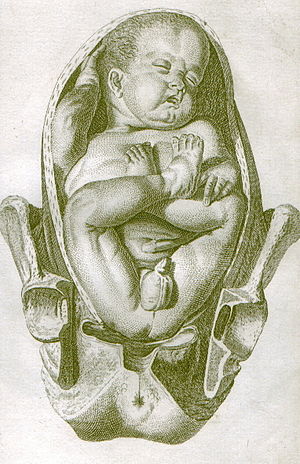Breech birth
| Breech birth | |
|---|---|
 |
|
| Frank breech, William Smellie, 1792 | |
| Classification and external resources | |
| Specialty | Obstetrics, Midwifery |
| ICD-10 | O32.1, O64.1, O80.1, O83.0, P03.0 |
| ICD-9-CM | 652.1 |
| DiseasesDB | 1631 |
| MedlinePlus | 002060 |
| eMedicine | med/3272 emerg/868 |
| MeSH | D001946 |
A breech birth occurs when a baby is born bottom first instead of head first. Around 3-5% of pregnant women at term (37–40 weeks pregnant) will have a breech baby.
Most babies in the breech position are born by a caesarean section because it is seen as safer than being born vaginally.
As most breech babies are delivered by caesarean section in developed countries, doctors and midwives may lose the skills required to safely assist women giving birth to a breech baby vaginally. Delivering all breech babies by caesarean section in developing countries may be very difficult to implement or even impossible as there are not always resources available to provide this service.
With regard to the fetal presentation during human gestation, three periods have been distinguished.
During the first period, which lasts until the 24th gestational week, the incidence of a longitudinal lie increases, with equal proportions of breech or cephalic presentations from this lie. This period is characterized by frequent changes of presentations. The fetuses in breech presentation during this period have the same probability for breech and cephalic presentation at delivery.
During the second period, lasting from the 25th to the 35th gestational week, the incidence of cephalic presentation increases, with a proportional decrease of breech presentation. The second period is characterized by a higher than random probability that the fetal presentation during this period will also be present at the time of delivery. The increase of this probability is gradual and identical for breech and cephalic presentations during this period.
In the third period, from the 36th gestational week onward, the incidence of cephalic and breech presentations remain stable, i.e. breech presentation around 3-4% and cephalic presentation approximately 95%. In the general population, incidence of breech presentation at preterm corresponds to the incidence of breech presentation when birth occurs.
A breech presentation at delivery occurs when the fetus does not turn to a cephalic presentation. This failure to change presentation can result from endogenous and exogenous factors. Endogenous factors involve fetal inability to adequately move, whereas exogenous factors refer to insufficient intrauterine space available for fetal movements.
Incidence of breech presentation among diseases and medical conditions with the incidence of breech presentation higher than occurs in the general population, shows that the probability of breech presentation is between 4% and 50%. These data are related to: 1. single series of medical entities; 2. collections of series for some particular medical entity; 3. data obtained from repeated observations under the same conditions; 4. series of two concomitant medical conditions.
...
Wikipedia
